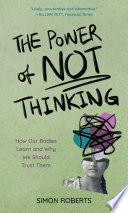

In a world dominated by data and analytics, the book emphasizes the importance of trusting one's intuition. Intuition is often dismissed as irrational or unfounded, but the author argues that it is a powerful tool for decision-making. Intuition allows individuals to draw on their experiences and subconscious knowledge to make quick judgments in complex situations. The book provides examples from various fields, including business and sports, where intuition has led to successful outcomes. By understanding the role of intuition, readers are encouraged to embrace their gut feelings rather than overanalyzing every situation.
Continue readingThe book discusses how overthinking can hinder creativity, productivity, and effective decision-making. The author explains that excessive rumination can lead to paralysis by analysis, where individuals become so bogged down in details that they fail to take action. This section explores the psychological mechanisms behind overthinking and offers strategies to combat it, such as mindfulness practices and setting time limits for decision-making. By recognizing the detrimental effects of overthinking, readers can learn to simplify their thought processes and focus on what truly matters.
Continue readingSimplicity is a recurring theme in the book. The author argues that complex solutions often lead to confusion and inefficiency. By simplifying problems and solutions, individuals can enhance clarity and effectiveness in their work. The book provides frameworks for simplifying tasks and decision-making processes, encouraging readers to strip away unnecessary complexities. This idea resonates particularly well in the context of technology and product development, where streamlined processes can lead to faster innovation and better user experiences.
Continue readingIn an unpredictable world, the ability to embrace uncertainty is crucial. The book discusses how fear of the unknown can paralyze decision-making and stifle creativity. By reframing uncertainty as an opportunity for exploration and growth, individuals can cultivate a mindset that is more adaptable to change. The author shares anecdotes from entrepreneurs and innovators who thrived by taking calculated risks and embracing the unknown. This idea encourages readers to view uncertainty not as a threat but as a canvas for potential.
Continue readingPlayfulness is often overlooked in professional settings, yet the book highlights its significance in fostering creativity and innovation. The author argues that a playful mindset encourages experimentation and exploration without the fear of failure. By incorporating play into their work, individuals can break free from rigid thinking patterns and discover new solutions. This idea is supported by research in psychology that shows how playfulness enhances cognitive flexibility and problem-solving abilities. The book provides practical suggestions for integrating playfulness into everyday tasks.
Continue readingCollaboration is presented as a vital component of effective decision-making and problem-solving. The author emphasizes that diverse perspectives lead to richer insights and better outcomes. By fostering a collaborative environment, teams can leverage the strengths of each member, leading to innovative solutions. The book discusses various collaboration techniques and tools that can enhance teamwork, as well as the importance of creating a culture that values open communication and trust. This idea underscores the notion that collective intelligence often surpasses individual expertise.
Continue readingThe book concludes with a focus on mindfulness and awareness as essential practices for enhancing clarity of thought. The author explains that being present in the moment allows individuals to make more informed decisions and reduces the noise of distractions. Mindfulness practices, such as meditation and reflective thinking, can help individuals cultivate a deeper awareness of their thoughts, feelings, and surroundings. By integrating mindfulness into daily routines, readers can improve their focus, creativity, and overall well-being, leading to more effective decision-making.
Continue reading